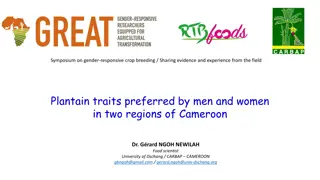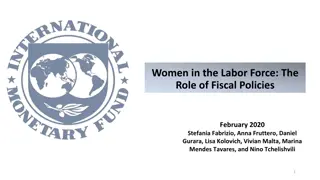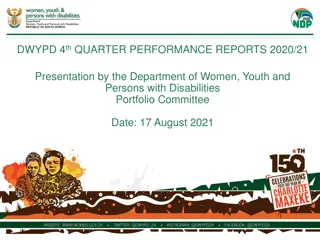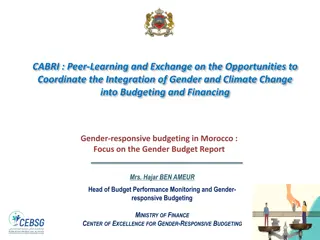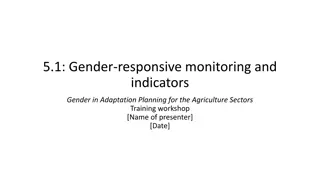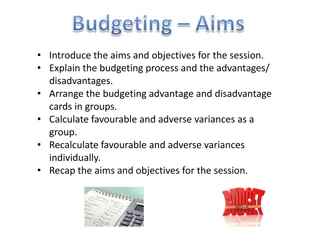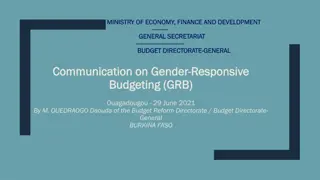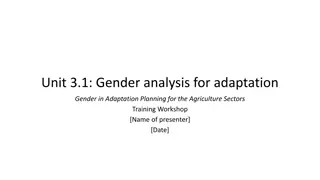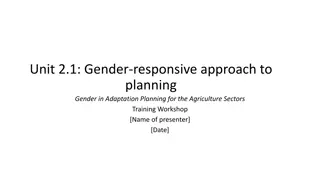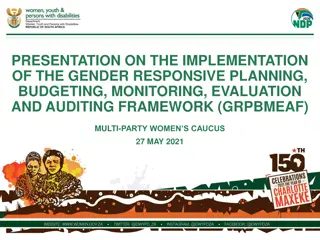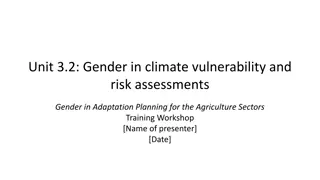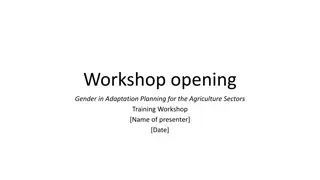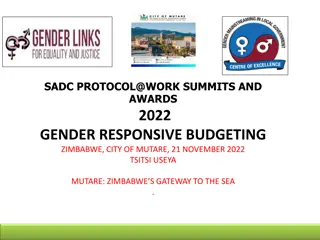Understanding Gender-Responsive Budgeting in Agriculture Sectors
Gender-responsive budgeting (GRB) aims to analyze the gendered impacts of budgets, promote gender equality, and women's rights in governmental budget allocation. It examines the effects on various genders regarding budget raising, spending, unpaid care work, and more. GRB is crucial for correcting gender biases, aligning budget allocations with gender equality commitments, addressing unpaid labor burdens, increasing transparency in resource utilization, and accounting for the costs of gender inequality on women, the economy, and societal development objectives.
- Gender-responsive budgeting
- Gender equality
- Agriculture sectors
- Government accountability
- Gender impacts
Download Presentation

Please find below an Image/Link to download the presentation.
The content on the website is provided AS IS for your information and personal use only. It may not be sold, licensed, or shared on other websites without obtaining consent from the author. Download presentation by click this link. If you encounter any issues during the download, it is possible that the publisher has removed the file from their server.
E N D
Presentation Transcript
Unit 4.2: Gender-responsive budgeting Gender in Adaptation Planning for the Agriculture Sectors Training Workshop [Name of presenter] [Date]
Learning outcomes Describe Describe what gender-responsive budgeting is and why it is important. Describe Describe a typical gender-responsive budgeting process. Identify possible sources of gender-responsive budgeting expertise in the government, NGOs, universities and other organizations. Identify Summarize Summarize some of the key gender requirements of climate finance mechanisms.
Part 1. Gender-responsive budgeting Aims to raise awareness of the gendered impacts of budgets and to make governments accountable for ensuring their budgets promote the achievement of gender equality and women s rights, especially among the poor. Involves analysing government budgets for their effect on different genders. Involves transforming these budgets to ensure that gender equality commitments are realised.
GRB examines impacts on women and men, girls and boys of: How money is raised and how revenues are lost; How money is spent; Whether spending is sufficient to meet the practical and strategic needs of men, women, girls and boys, while at the same time contributing to closing the gender gap; How decisions on raising and spending money affect unpaid care work and subsistence work, and the distribution of these between genders; and Whether spending in practice matches budget plans.
Why GRB? To correct gender biases in budgets and fiscal policy To demonstrate how government commitments to gender equality and women s empowerment are translated into allocations to public programmes To account for the gender differences between and within households; To address the unpaid labour burden of women and to monitor care- related programmes; To increase transparency in use of public resources as well as in public policy formulation, implementation and impact; To account for the costs that gender inequality has for women, the economy, and the broad developmental objectives of a society (e.g. overburdening women can lead to productivity losses).
Key considerations in GRB Approach, e.g. Five-step Method When during the adaptation process, e.g. as part of integrating climate change into a national budgeting process, or within a budgeting process for the agriculture sector. Strong leadership and multiple stakeholders needed Instigator may be a gender budgeting statement at national level
Gender-responsive budgeting steps in the agriculture sector
Part 2. Gender in climate finance Climate finance encompasses local, national or transnational financing that seeks to support mitigation and adaptation actions that will address climate change. Climate finance emerged under the UNFCCC negotiations as a means for countries with more resources to provide financial assistance to those with fewer resources and higher vulnerability to the impacts of climate change. Climate finance comes from multiple sources: Private multilateral (World Bank, UN, etc.) Bilateral (largely as part of overseas development assistance) within the context of the UNFCCC domestic allocations
Gender policies/plans in all major climate financing mechanisms A country s ability to leverage financial resources needed to implement an adaptation plan for agriculture will be based partly on the extent to which it demonstrates compliance with the funding mechanism s gender requirements.




